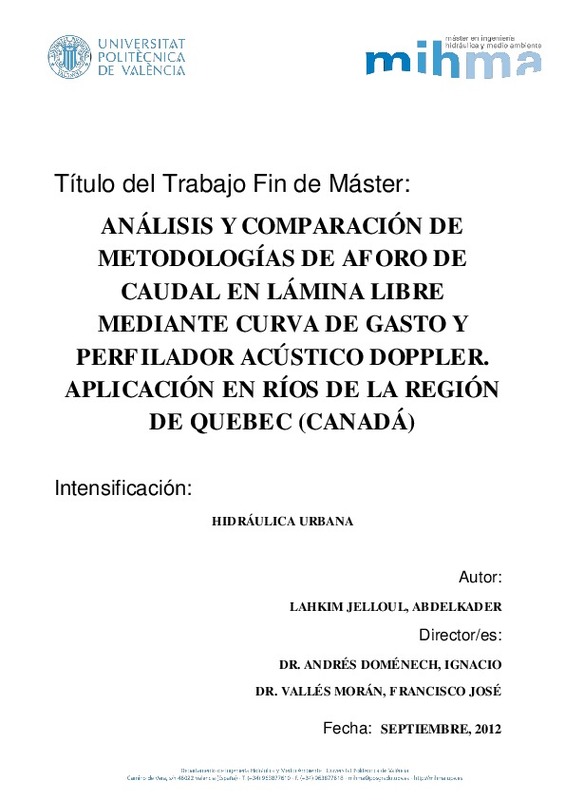|
Resumen:
|
[ES] La determinación del caudal en lámina libre es un ejercicio complejo, pero indispensable para la resolución de varios problemas a los que los técnicos se enfrentan a menudo, sea en el campo de los recursos hídricos o ...[+]
[ES] La determinación del caudal en lámina libre es un ejercicio complejo, pero indispensable para la resolución de varios problemas a los que los técnicos se enfrentan a menudo, sea en el campo de los recursos hídricos o en redes de saneamiento para conocer mejor y predecir los caudales que son generalmente utilizados para fines económicos, sociales o medioambientales. Para ello, es indispensable disponer de instrumentos adecuados capaces de medir de manera precisa, detallada y con coste inferior, los distintos parámetros necesarios para los estudios a realizar. Afortunadamente, durante los últimos 20 años, la posibilidad de disponer de sistemas informáticos y electrónicos muy sofisticados a precios reducidos, ha conducido al desarrollo de instrumentos electrónicos para la medición de la velocidad, el nivel de la lámina de agua y el caudal, con mucha precisión y fiabilidad, lo que ha evolucionado la hidrometría. Hoy en día, los medidores electrónicos de velocidad que utilizan técnicas acústicas, de radar o por imagen están revolucionando la medida de caudales en los cauces. Cada vez más, estos sistemas están remplazando a los instrumentos mecánicos, convirtiéndose así en los instrumentos predilectos para medir el caudal. Estos instrumentos ofrecen unas prestaciones superiores en términos de eficacia, rendimiento y seguridad.
Un enfoque relativamente reciente para el aforo de caudal en lámina libre, consiste en medir la velocidad y la profundidad del flujo mediante el perfilador acústico Doppler (Acoustic Doppler Current Profiler, ADCP) para calcular el caudal, un instrumento de medida muy preciso en condiciones ideales de utilización. Para ello, en el siguiente trabajo se analiza el funcionamiento del ADCP en diferentes contextos, comparándolo con el método clásico: la curva de gasto, que consiste en llevar una campaña de medidas puntuales, permitiendo establecer simultáneamente el caudal y la profundidad, por lo medios más precisos posible, con el fin de calibrar una relación que mediante una única medida de profundidad, permite obtener el caudal. Este enfoque clásico tiene una base teórica bastante solida y se basa sobre tecnologías probadas para medir la velocidad y la profundidad. Desgraciadamente, es difícil obtener medidas nivel-caudal en situaciones extremas, ya que generalmente no suele haber equipos de medida en terreno cuando se produce un evento extremo.
Asimismo, el ADCP tiene la ventaja de proporcionar de manera segura gran cantidad de medidas que cubren toda la gama de valores necesarios para calibrar una curva de gasto, que a su vez resulta más ventajosa en el plan económico y operacional, para proporcionar medidas con menos fluctuaciones que el ADCP, por lo que claramente se puede deducir que existe una sinergia entre los dos métodos.
[-]
[EN] Determination of the open channel flow is a complex exercise but it is essential in order to solve the problems that technicians often face to better understand and predict discharges which are generally used for ...[+]
[EN] Determination of the open channel flow is a complex exercise but it is essential in order to solve the problems that technicians often face to better understand and predict discharges which are generally used for commercial, social or environmental purposes, whether in the field of water resources or in sewerage networks. For this aim, it is essential to have adequate instruments which are able to measure accurately, detailed and with a reasonable cost, the different parameters needed for studies to be performed. Nowadays, electronic speed meters using acoustic techniques, radar or imaging are revolutionizing the flow measurement in open channels. Increasingly, these systems are replacing mechanical instruments and they are becoming reference instruments to measure flows. These instruments offer superior performance in terms of efficiency, performance and security.
A relatively recent approach to obtain the open channel flow is to measure the speed and flow¿s depth using acoustic Doppler profiler (Acoustic Doppler Current Profiler, ADCP) to calculate the discharge, a very precise measuring instrument when used in ideal conditions. In this way, the following paper analyzes the performance of the ADCP in different contexts, comparing it with the classical method: the stage-discharge curves. This classical method consists in doing a campaign of one-off measures, allowing the determination of flow and depth simultaneously as precise as possible, in order to calibrate a relationship that, using a single measure of depth, enables to calculate the corresponding flow.
Furthermore, firstly a pilot phase is developed in order to learn and use properly the new technologies and associated instrumentation to measure the instantaneous velocities in open channel flow: the ADCP. Its configuration, commissioning and procurement data will be done. Then their operation will be validated, first by comparing the flow channel obtained in a laboratory with those obtained using a calibrated electromagnetic flow meter and a gage, and secondly performing an experimental theoretical contrast between the ADCP and the stage-discharge curve obtained in the classical formulas of hydraulics.
Secondly, we analyze data from three rivers in the region of Quebec (Canada), assess the discrepancies between the estimated flow rating curve and flow measured by ADCP and finally, determine whether the stage-discharge curve is able to reproduce the measurements obtained by the ADCP.
[-]
|







